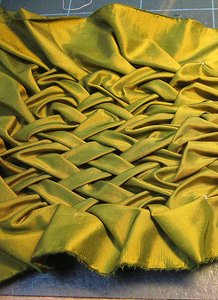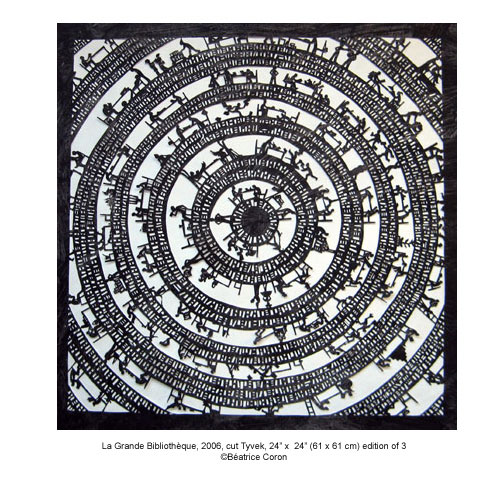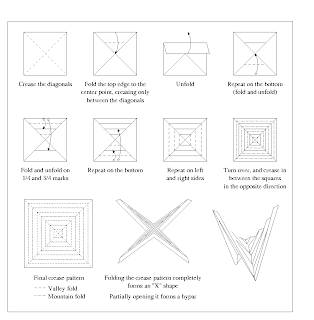Sunday, 24 March 2013
Ideas
After researching into manipulation of different materials I have seen a common occurrence in the results of these techniques. Many of these techniques produce work containing repetition of shapes or lines, these create a geometrics feel. This is something I would like to research further and influence my work. I like the way that in geometric patterns everything is precise and clean cut, something which is new to me in my work but always been something I would like to experiment with. I like the idea of my work looking inorganic and manmade. I would like to create work with straight lines, sharp angles and clean edges. I will also include geometric shapes such as triangles and hexagons, but will have to research into this more.
Matt Shlian
Matt Shlian is a great artist and paper engineer, he works with paper by folding, cutting and gluing. He uses his engineering skills to create kinetic sculpture which have lead to him collaborations with scientists at the University of Michigan. They work on the nanoscale, translating paper structures to micro origami and also investigate into visualizing cellular division and solar cell development. Matt Shlian explains how he works;
'In my studio I am a collaborator, explorer and inventor. I begin with a system of folding and at a particular moment the material takes over. Guided by wonder, my work is made because I cannot visualize its final realization; in this way I come to understanding through curiosity.'
'In my studio I am a collaborator, explorer and inventor. I begin with a system of folding and at a particular moment the material takes over. Guided by wonder, my work is made because I cannot visualize its final realization; in this way I come to understanding through curiosity.'
Matt Shlian's geometric sculptures elegantly reflect his connection to the scientific communities. He explores the physicality of paper with his curiosity-driven approach. Creating his work through problem solving and experimentation. Shlian restricts his palate to monochrome shades of white, this enhances the effects the light plays on the folds creating large areas of shade. He creates his stunning paper sculptures using both low-tech (scissors, knives, glue) and hi-tech tools (plotters, AutoCAD). His works can be seen as both abstract and organic, or precise and geometric.
Shlian's collaborations with scientists at the University of Michigan have lead him onto investigate into visualizing cellular division and solar cell development. His intricate forms also take on the complexity of natural design, suggesting the cellular lattices at the root of biological mechanics.
---------------------------------------
I love his uses for folding to turn a flat piece of paper into a three dimensional form and will be investigating into this to use within my work. I want to see how different folds create different patterns within the paper and how this manipulation add a new depth to the work by introduction a new selection of shadows. I am also interested by his use of only white paper and feel this creates a clean and somewhat clinical feel. I would like to experiment with the use of this within my work as I would like my work to express a synthetic and artificial feel.
Thursday, 21 March 2013
Late night Ideas...
Ideas always come to me with I'm trying to get to sleep, maybe its because it the only time I stop filling it with 'jargon' and let my mind run free. So my ideas...
- Using white paper for origami tessellations but cut out the middle of some of the shapes.
- filling the middle with coloured transparent paper
- filling the middle with different manipulated fabric
- filling the middle with transparent neon fabric with has been manipulated
- origami tessellations using acetate
- Using white paper for origami tessellations but cut out the middle of some of the shapes.
- filling the middle with coloured transparent paper
- filling the middle with different manipulated fabric
- filling the middle with transparent neon fabric with has been manipulated
- origami tessellations using acetate
 |
this kind of neon fabric, PVC (I think) |
Paper Cut
Paper cut is another way of manipulation paper. In paper cutting your only tool is your knife and your drawings or patterns are created thought only the paper and the negative space. The pieces created can be either 2D or 3D. There was recently an exhibition at Manchester art gallery called 'First Cut'
1. 2D paper cut: This piece is by Beatrice Coron (http://beatricecoron.com/).
2. Installation paper Cut: This piece is by Andreas Kocks (http://www.andreaskocks.com/index.html)

3. 3D paper cut; This piece here is by Elod Beregszaszi (http://www.popupology.co.uk/galleries)

4. Sculptural Paper Cut: This piece is my Peter Callesen

Origami Tessellations
Now moving on to paper, there are many different ways of manipulation paper but not as many as fabric. Paper is a firmer material and harder to manipulate as its less flexible. I am starting with origami tessellations. This is done by only folding the paper which creates sharp, crisp edges and angles and usually make some great geometric effects. There are many different types of origami tessellations however them aren't all named as the different pleats and tucks are in textiles, so I will just be naming them by what shapes are created when folding.
1.Parallelogram Folding
Its is made up of many parallelogram folded in different directions to create this effect. http://www.graficaobscura.com/fold/page004.html
2. Paper folder Balls
These balls are made up of many folded circle all attached together to form a 3D ball
http://rhymeswithmagicart.blogspot.co.uk/2011/11/paper-ball-ornaments-tutorial.html
3. Triangle Folding
This is made up of many triangles folding in different directions like the parallelogram. Its is a very difficult one to make and I have so far not found any guides on how to make it.
4. Folded Square
This is a square which has had been folded into four triangles and been folded into zigzags. Below are the instruction on how to do this;

This is another one using triangles folded in different directions, however this one cannot lay flat and is curved round. This used a grid which consists of diagonal line in both ways and line is either horizontal OR vertical.
6. Right angel Triangle Folding
This is created but folding rights angle triangles in opposite directions. I like the swirl created on this one.
There are many more different origami tessellations . I have found a great book 'Folding Techniques for Designers: From Sheet to Form' which has step by step guides on how to create different tessellations, most of the 3D as well which is what I want to look at.
1.Parallelogram Folding

Its is made up of many parallelogram folded in different directions to create this effect. http://www.graficaobscura.com/fold/page004.html
2. Paper folder Balls

These balls are made up of many folded circle all attached together to form a 3D ball
http://rhymeswithmagicart.blogspot.co.uk/2011/11/paper-ball-ornaments-tutorial.html
3. Triangle Folding

This is made up of many triangles folding in different directions like the parallelogram. Its is a very difficult one to make and I have so far not found any guides on how to make it.
4. Folded Square
This is a square which has had been folded into four triangles and been folded into zigzags. Below are the instruction on how to do this;
5.Trainge Folding This is another one using triangles folded in different directions, however this one cannot lay flat and is curved round. This used a grid which consists of diagonal line in both ways and line is either horizontal OR vertical.
6. Right angel Triangle Folding
This is created but folding rights angle triangles in opposite directions. I like the swirl created on this one.
There are many more different origami tessellations . I have found a great book 'Folding Techniques for Designers: From Sheet to Form' which has step by step guides on how to create different tessellations, most of the 3D as well which is what I want to look at.
Wednesday, 20 March 2013
Tucks
Tucks are textile technique that creates detail on a flat piece of fabric. Tucks work with folding and sewing fabric. They are very similar to pleats but not the same.
Pin tucks: Are small tucks sew in parallel lines
Diamond pin tuck: The same as pin tucks but in a diamond shape, but instead of just parallel line in one direction they are in both horizontal and vertical directions but diagonally.
Centered tucks with bow ties: these are two wider tucks parallel pinched together in intervals and joined to create a bow tie look.
Cross tucking: these are made up of multiple tucks in a variety of sizes placed horizontally and vertically
Smock tucks: made from rows of tucks all joined at different intervals to create diamonds shapes.
Undulating tucks: these are made up of wider tucks which are sew to flatten then down in alterative ways
Gathering
Gathering can be done in a few different ways however they all have similar outcomes. I will be researching the different ways of gathering so when I come to experimenting I can see which ones and the more efficient in the time it takes to make them and the looks they create.
Gathering with Elastic: Gathering with elastic is quicker to do as the elastic does all the gathering for you. It create tight gathers which have a stretch to them.






Gathering with Elastic: Gathering with elastic is quicker to do as the elastic does all the gathering for you. It create tight gathers which have a stretch to them.

Gathered strip: Gathered material placed in-between to strips of flat material
Cross Shirring: Row of gathering vertical and horizontal
Star Gathering: Gathering of material to create star/ diamond shapes
Gathered double edge ruffles: A gather strip of material on top of another piece of material to create a ruffle effect
These are different ways in which you can create a horizontal gathering.

Smocking
Smocking is another way of manipulating material, used in the olden day to create stretch in fabric before elastic was used. Smocking is not only useful but also create great patterns in the fabric.
Straight Smocking: straight smalls pleats with a straight sticks running thought all the pleats.
http://tipnut.com/smocking/
http://tipnut.com/smocking/

Lattice Smocking: A lattice pattern with crossing diagonal pleating
http://blackbirdblues.livejournal.com/56295.html?thread=88551

Flower Smocking: A flower patters create by the pleats in the fabric
http://mypatchwork.wordpress.com/2012/11/10/block-23-lotus-flower-smocking-textured-quilt-sampler/
Longer smoking: short pleats in alternative rows.
Pleats
Pleats can transform a flat/ 2 dimensional fabric into something more... There are many different types of pleat all looking different and creating different textures. I am researching these different pleats so I can experiment with them on different materials. I want to find out the different types of pleats and which ones I could possibly use in my final outcome.
Knife Pleats: is a single pleat turned in one direction
Box pleat: a double pleat having two upper folds facing in opposite directions and two under folds pressed toward each other
Inverted Pleat: is a box pleat reversed so that the fullness of the material is turned inwards
Pinch pleat: is a triple pleat all in one direction with a pinch joining them all together in the middle
Honeycomb: Honeycomb pleats are plain strange and actually look like honeycombs. This type of fabric is usually used as a basis for smocking.
Subscribe to:
Posts (Atom)























